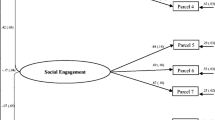Abstract
Discriminant analyses and stepwise multiple regression techniques were applied to teacher ratings of 184 kindergarten through eighth-grade students using Stephen's Social Behavior Assessment (SBA) inventory and were used to predict group membership as emotionalyy disabled (ED) or non-ED. The results suggested that the SBA was highly effective in correctly discriminating ED from non-ED students. The linear discriminant function derived from the 30 SBA subcategories correctly classified 83% of the subjects, yielding a highly significant separation of groups of ED and non-ED children. While the results of the discriminant analyses have not yet been cross-validated, these findings support the discriminant validity of the SBA for ED versus non-ED classification and suggest that the SBA is potentially a useful instrument for school psychologists as one source of information in a multifactored assessment regarding the identification of children as ED.
Similar content being viewed by others
References
Bolstad, O. D., and Johnson, D. M. The relationship between teachers' assessment of students and the students' actual behavior in the classroom.Child Development 1977,48 570–578.
Bower, E. M.Early identification of emotionally handicapped children in school. Springfield, Ill.: Charles C Thomas, 1969.
Cartledge, G., and Milburn, J. F. (Eds.)Teaching social skills to children. New York: Pergamon Press, 1980.
Cowen, E. L., Pederson, A., Babigian, H., Izza, L. D., and Trost, M. A. Longterm follow-up of early detected vulnerable children.Journal of Consulting and Clinical Psychology 1973,41(3), 438–446.
Foster, S. L., and Ritchey, W. L. Issues in the assessment of social competence in children.Journal of Applied Behavioral Analysis 1979,12 625–638.
Green, K. D., and Forehand, R. Assessment of children's social skills: A review of methods.Journal of Behavioral Assessment 1980,2(2), 143–159.
Greenwood, C. R., Walker, H. M., Todd, N. M., and Hops, H. Validating teacher selection with normative data for preschool social interaction. Presented at the 84th Annual Meeting of the American Psychological Association, Washington, D.C., September 1975.
Greenwood, C. R., Walker, H. M., and Hops, H. Issues in social interaction/withdrawal assessment.Exceptional Children 1977,43 490–499.
Gresham, F. M. Assessment of children's social skills.Journal of School Psychology 1981,19 120–133.
Gresham, F. M. Social skills assessment as a component of mainstreaming placement decisions.Exceptional Children, 1982,48, in press.
Iowa Department of Public Instruction.Rules of special education. Des Moines: Iowa Department of Public Instruction, 1977.
Kerlinger, F. N., and Pedhazur, E. J.Multiple regression in behavioral research. New York: Holt, Rinehart & Winston, 1973.
Kohn, M. L., and Clausen, J. A. Social isolation and schizophrenia.American Sociological Review 1955,20(3), 265–273.
Milburn, J. F.Special education and regular class teachers attitudes regarding social behaviors of children: Steps towards the development of a social skills curriculum Unpublished doctoral dissertation. Columbus: Ohio State University, 1974.
Morgan, S. R. A descriptive analysis of maladjusted behavior in socially rejected children.Behavioral Disorders 1978,4(1), 23–30.
Nelson, C. M. Techniques for screening conduct disturbed children.Exceptional Children 1971,37 501–507.
Nie, N. H., Hull, C. H., Jenkens, J. G., Steinbrenner, K., and Bent, D. H.Statistical Package for the Social Sciences 2nd ed. New York: McGraw-Hill, 1975.
Nunnally, J. C.Psychometric Theory 2nd ed. New York: McGraw-Hill, 1978.
Pekarik, E. G., Prinz, R. J., Liebert, D. E., Weintraub, S., and Neale, J. M. The pupil evaluation inventory: A sociometric technique for assessing children's social behavior.Journal of Abnormal Child Psychology 1976,4(1), 83–97.
Quay, H. C., Morse, W. C., and Culter, R. L. Personality patterns of pupils in special classes for the emotionally disturbed.Exceptional Children 1966,32 297–301.
Roff, M. Some life history factors in relation to various types of adult maladjustment. In M. Roff and D. Ricks (Eds.),Life history research in psychopathology. Minneapolis: University of Minnesota Press, 1972.
Siegel, L. J., Dragovich, S. L., and Margolin, D. The effects of biasing information on behavioral observations and rating scales.Journal of Abnormal Child Psychology 1976,4(3), 221–233.
Statistical Analysis System Institute.Statistical analysis system. Raleigh, N. C.: SAS Institute, 1979.
Stephens, T. M.Social skills in the classroom. Columbus, Ohio: Cedars Press, 1978.
Stephens, T. M.Social behavior assessment. Columbus, Ohio: Cedars Press, 1979.
Stephens, T. M.Technical information: Social behavior assessment. Columbus, Ohio, Cedars Press, 1980.
Tatsuoka, M. M.Multivariate analysis: Techniques for educational and psychological research. New York: John Wiley & Sons, 1971.
Ullmann, C. Teachers, peers, and tests as predictors of adjustment.Journal of Educational Psychology 1957,48 257–267.
Victor, J. B., and Halverson, C. F. Behavior problems in elementary school children: A follow-up study.Journal of Abnormal Child Psychology 1976,4 17–29.
Walker, H. M. Empirical assessment of deviant behavior in children. In N. J. Long, W. C. Morse, and R. G. Newman (Eds.),Conflict in the Classroom 2nd ed. Belmont, Calif.: Wadsworth, 1971.
Weintraub, S., Neale, J. M., and Liebert, D. E. Teacher ratings of children vulnerable to psychopathology.American Journal of Orthopsychiatry 1975,45(5), 838–845.
Weintraub, S., Prinz, R. J., and Neale, J. M. Peer evaluations of the competence of children vulnerable to psychopathology.Journal of Abnormal Child Psychology 1978,6(4), 461–473.
Author information
Authors and Affiliations
Rights and permissions
About this article
Cite this article
Stumme, V.S., Gresham, F.M. & Scott, N.A. Validity of Social Behavior Assessment in discriminating emotionally disabled from nonhandicapped students. Journal of Behavioral Assessment 4, 327–341 (1982). https://doi.org/10.1007/BF01341228
Accepted:
Issue Date:
DOI: https://doi.org/10.1007/BF01341228




